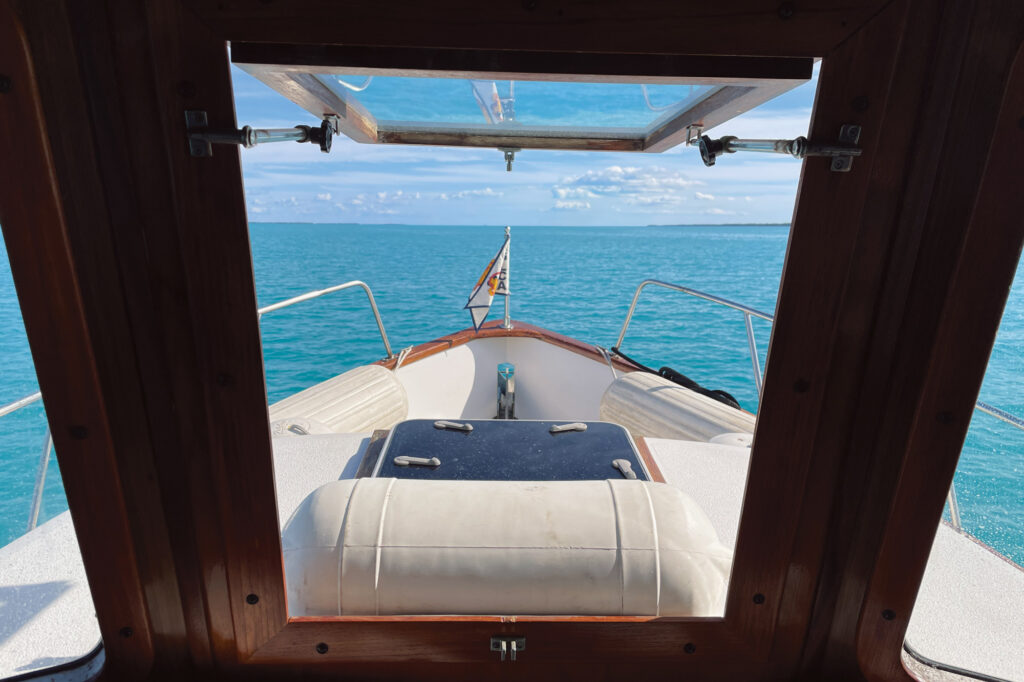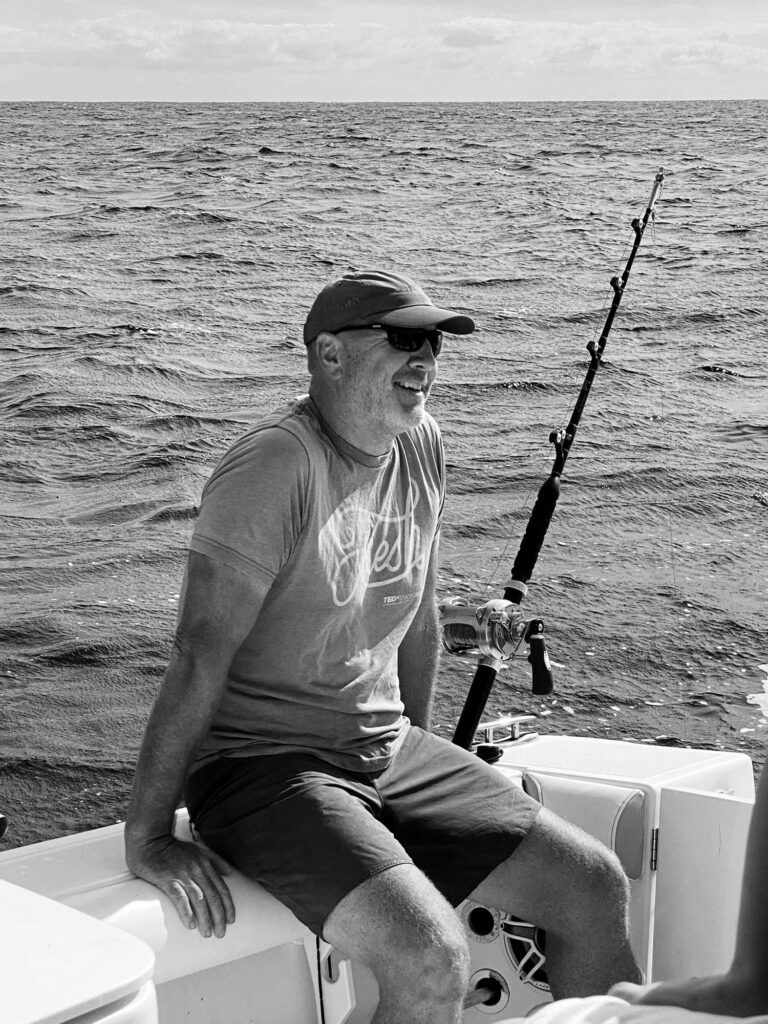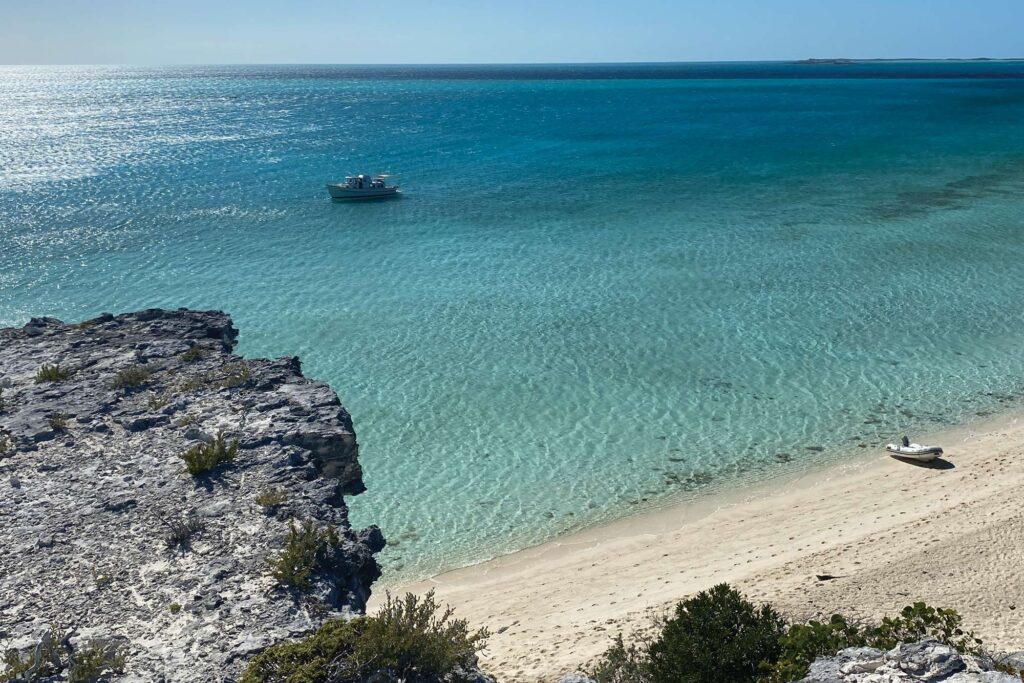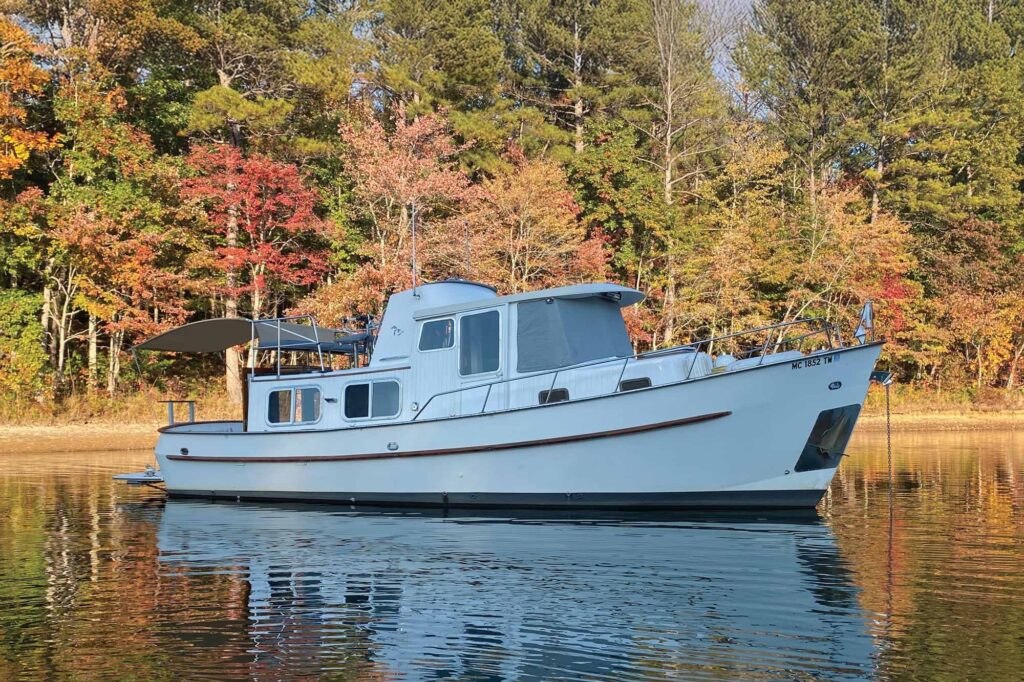SB Television
The Next Chapter: A Boat Designer’s Journey
 Andrew Bartlett learned that the America’s Great Loop Cruisers’ Association burgee comes with a community.
Courtesy Andrew Bartlett
Andrew Bartlett learned that the America’s Great Loop Cruisers’ Association burgee comes with a community.
Courtesy Andrew Bartlett
Andrew Bartlett has been with Tiara Yachts for 25 years, and in the marine industry for 35. Like so many people at that stage of life, he thought it would be at least a few more trips around the sun before he could finally retire and do something epic with his wife out on the water.
But then a day came along when the timing somehow seemed right.
“It’s a little unnerving to go into your boss’s office and ask for that sabbatical,” he says, “but in my case, it worked out.”
Bartlett had been training his successor in the role of Tiara’s design director, so there was someone ready to keep new models cooking in the pipeline. At the same time, Tiara’s leadership saw value in Bartlett doing some long-distance cruising to learn firsthand about features and systems. And his family life presented an opportunity.
 Bartlett says that at Tiara, he and his team have been exploring the idea of dayboats without generators, so the insights he gained are a good fit for the company’s thinking.
Courtesy Andrew Bartlett
Bartlett says that at Tiara, he and his team have been exploring the idea of dayboats without generators, so the insights he gained are a good fit for the company’s thinking.
Courtesy Andrew Bartlett
“My wife and I are empty nesters now,” he says. “Our son just graduated from the University of Michigan and settled into his first job in Chicago, so this is a new chapter for us. Right now, we’re healthy and spry. Originally, this was going to be for retirement, but we moved it up.”
The boat he chose for this Great Loop adventure is a 1985 Transpac Eagle 32 that cruises at 6 or 7 knots. It’s a salty tug named Tortuga that he bought and then spent five years fixing up, including adding systems and electronics for his bucket-list cruise—but in a way that would give him real-world insights into boat design of the future.
“There was no generator on board, so I decided against adding one,” he says. “I wanted to explore and experience where I believe the boating industry is headed, which is a lithium-iron-sulphate house bank. That was a great experience for a boat designer to go through, and I dragged my wife through the process with me.”
He started by listing all the refrigeration, laptop computer and other power-draw items they wanted on board, and then figured out how to install enough batteries and a way to charge them that would mesh with their cruising plan.
 The Bahamas “was amazing,” Bartlett says. “We’ll find a way to get back there. We’re going back.”
Courtesy Andrew Bartlett
The Bahamas “was amazing,” Bartlett says. “We’ll find a way to get back there. We’re going back.”
Courtesy Andrew Bartlett
“To power all of that remotely while you’re on anchor or at a free wall in Beaufort, South Carolina, which is where we’re heading today, there’s a range of conditions you’re going to be in,” he told Yachting in early April. “The Bahamas, especially, you’re in some really remote places. That’s the beauty, but it’s also the difficulty. You have to be capable to be there.”
Bartlett says that at Tiara, he and his team have been exploring the idea of dayboats without generators, so the insights he gained are a good fit for the company’s thinking. He also installed two other trending types of equipment: solar panels and Starlink. “I have to really commend that system,” he says, adding that his wife, Kate, works from the boat. “Remoteness can be difficult, and Starlink does a really good job.”
Since setting off from Saugatuck, Michigan, this past September, he’s learned the true advantages of a full walkaround design. “And the two pilothouse doors on both sides, that ability to participate and help with locking and docking, that’s so helpful,” he says. “And the lower station, that’s something I thought that I would use a lot, but it’s indispensable for long-range cruising. Up on top, near the fake smokestack, there’s an upper station. It’s a huge advantage for visibility at the upper helm, and then to get down and be more comfortable at the lower helm while motoring for eight hours, it’s a good combination.”
 The Transpac Eagle 32 with a raised pilothouse is often described as a “rare find” in the brokerage market, and it’s a favorite among couples who are interested in living aboard for long-distance cruising.
Courtesy Andrew Bartlett
The Transpac Eagle 32 with a raised pilothouse is often described as a “rare find” in the brokerage market, and it’s a favorite among couples who are interested in living aboard for long-distance cruising.
Courtesy Andrew Bartlett
Many of the choices, he says, came with help from Tiara’s team. He’d talk with new-product development people and engineers about things like anchoring systems. (He went with Delta but also likes Rocna.)
He and Kate also prepared for the journey by starting out with a trio of two-week cruises over three years. And they involved friends in their plans—more than 22 friends, actually. All of them rented landside spots on George Town in the Exumas—which meant the couple had a deadline for making it down the Mississippi River, across the Gulf to Florida, and over to the Bahamas.
“My wife and I both enjoy snorkeling, and we really enjoyed it there,” he says. “The healthy reef was just breathtaking. We spent two and a half months there. It was our goal to get to the Bahamas, and we suspected it would be a highlight. It was, and we stayed. We were there from New Year’s Eve day and didn’t leave until the middle of March.”
As of this writing, they were cruising up the East Coast, headed for Canada this summer and then back to the Great Lakes. They’ve become big fans of the America’s Great Loop Cruisers’ Association as a safety net of fellow Loopers, and they use the Mebo app to track where all their cruising friends are.
 The couple are taking their time, cruising at 6 or 7 knots and enjoying the Great Loop’s many views.
Courtesy Andrew Bartlett
The couple are taking their time, cruising at 6 or 7 knots and enjoying the Great Loop’s many views.
Courtesy Andrew Bartlett
Everything he’s experienced, Bartlett says, will be a boon for Tiara’s future designs.
“I can bring so much of that back to our young team of designers and be somebody who can provide that experiential conversation, debate and critique to new products at Tiara,” he says. Nobody should expect the brand to produce a trawler anytime soon, he adds, but Tiara’s EX series is all about cruising, and he’s soaking up everything he can about that lifestyle.
“I do like to think it was a win-win,” he says of his Great Loop sabbatical. “That just doesn’t happen often enough in life.”
Living and Breathing Boat DesignBartlett has been with Tiara Yachts long enough to have helped transition the portfolio through a few different iterations. “We started out as a sportboat company with the Tiara Opens,” he says, “but I helped, as a team member, usher in the Coupe series. That got us into more of the pleasure boating, and most recently into the outboards and the dayboating experience.”
Buying TortugaA good friend of Bartlett’s owned the Transpac Eagle 32 that he would eventually buy. He had his eye on the boat for quite a while before his friend was finally ready to let it go. “He’s also a boat lover,” Bartlett says. “He purchased the boat that I ended up doing the Loop in. I’d visit him annually during boat shows, and I finally talked him into selling me this trawler.”
Transpac Eagle 32This trawler with a raised pilothouse is often described as a “rare find” in the brokerage market, and it’s a favorite among couples who are interested in living aboard for long-distance cruising. A 1987 hull can run around $75,000, as a point of reference, and quite a lot of brokerage ads mention that the boat is a good choice for cruising the Great Loop. Bridge clearance is about 10 feet with a draft of about 3 feet, 6 inches. The boat is meant to sleep two people overnight, but it can take four if there are occasional guests along the way.
Adventure on the MoveOne of the things Bartlett says drew him to the idea of cruising the Great Loop instead of, say, heading offshore was that the Loop is something big but also safe, especially if you stay within the continental United States. It’s also a route that places demands on the skipper and mate to be fully present in the experience. “You’re always within the sight of land, but it’s an adventure, not a vacation,” he says. “You’re always moving and planning and seeing things you haven’t seen before. We added the adventure of going blue water over to the Exumas, rather than going to the Keys, and that was thrilling.”
Remote Cruising, but Civilized“We’re all energy addicts. We like our stuff,” Bartlett says. But at the same time, he’s been hearing more and more boaters say they want designs that allow them to use all their stuff without a generator to power it. So, that’s what he did. “Nobody wants to listen to a generator. You’d prefer to have silence,” he says. He also wanted air conditioning and heat, so he installed those systems too.
No Need for SpeedThe ability to cruise fast can be helpful, Bartlett says, “But 99 percent of the time, at least on the Loop and this particular adventure, most people go about 8 knots, forever and ever and ever, down all the river systems and through the Intracoastal Waterway that has a lot of no-wake zones. People are taking in the scenery. They’re saving money on fuel at that speed.”
The post The Next Chapter: A Boat Designer’s Journey appeared first on Yachting.
- Home
- About Us
- Write For Us / Submit Content
- Advertising And Affiliates
- Feeds And Syndication
- Contact Us
- Login
- Privacy
All Rights Reserved. Copyright , Central Coast Communications, Inc.